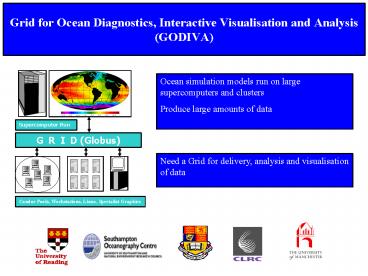Grid for Ocean Diagnostics, Interactive Visualisation and Analysis GODIVA - PowerPoint PPT Presentation
Grid for Ocean Diagnostics, Interactive Visualisation and Analysis GODIVA
Grid for Ocean Diagnostics, Interactive Visualisation and Analysis GODIVA – PowerPoint PPT presentation
Title: Grid for Ocean Diagnostics, Interactive Visualisation and Analysis GODIVA
1
Grid for Ocean Diagnostics, Interactive
Visualisation and Analysis (GODIVA)
2
Basic capabilities
3
Web Services
- Powerful way to implement distributed computing
modular, loosely-coupled - Platform neutral
- Message passing in machine-independent form
- Existing code can be easily converted to WS form
- Client can be desktop, handheld PC, mobile phone,
another Web Service, etc - Future Grid Services
- Extend WS to add features to help Grid computing
4
Web and Grid servicesfor large model data sets
- (Data discovery) NERC DataGrid
- Distributed Data Management Layer (GADS)
- Data Delivery Service (http, ftp, gridftp,
security) - Visualisation Services (Server side, distributed,
client side) - Data Transformation services (interpolation,
re-mapping) - Diagnostics and intercomparison services (Grid
Services)
5
Grid Access Data Service (GADS)
dataQuery()
Data (GRIB, NetCDF, HDF)
6
Data sets currently served
- Met Office real time ocean forecasts at 1, 1/9
resolution - ECMWF surface Met conditions (10 day forecasts)
- High Resolution ocean model data (1/12 OCCAM)
- Some satellite data e.g. TRMM (provided by SOC)
7
Bringing Web Services together
a.k.a. Orchestration
Perform diagnostics
Compare datasets
Visualise results
Convert format
8
GODIVA Data Portal
(movie)
9
The Future
- Reading e-Science Centre (ReSC)
- Promote Web and Grid Service technology across
environmental science community Open Source - Academic community (Data Assimilation Research
Centre) - Met Office, Environment Agency
- ECMWF and EU Framework e.g. MERSEA
- Commercial sector (SEEDA project, BMT and
Maritime Coastguard Agency for Oil spill, Search
and Rescue) - Further collaborations and inter-operability with
other environmental science Grids
10
Conclusions
- Developing techniques and tools for working with
very large data sets - Of general use, not just for oceanographers
- Web Services are very important
- Enables collaboration across institutions and
national borders - Applications to both public and commercial sectors
PowerShow.com is a leading presentation sharing website. It has millions of presentations already uploaded and available with 1,000s more being uploaded by its users every day. Whatever your area of interest, here you’ll be able to find and view presentations you’ll love and possibly download. And, best of all, it is completely free and easy to use.
You might even have a presentation you’d like to share with others. If so, just upload it to PowerShow.com. We’ll convert it to an HTML5 slideshow that includes all the media types you’ve already added: audio, video, music, pictures, animations and transition effects. Then you can share it with your target audience as well as PowerShow.com’s millions of monthly visitors. And, again, it’s all free.
About the Developers
PowerShow.com is brought to you by CrystalGraphics, the award-winning developer and market-leading publisher of rich-media enhancement products for presentations. Our product offerings include millions of PowerPoint templates, diagrams, animated 3D characters and more.































